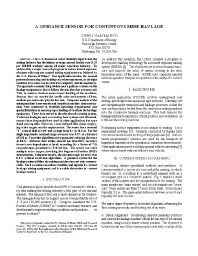Mining Publication: A Guidance Sensor for Continuous Mine Haulage
Original creation date: October 1996
Authors: JJ Sammarco
NIOSHTIC2 Number: 10008564
IAS '96: Conference Record of the 1996 IEEE Industry Applications Conference: Thirty-first IAS Annual Meeting, October 6-10, 1996, San Diego, California. Piscataway, NJ: Institute of Electrical and Electronics Engineers, 1996 Oct; 4:2465-2472
The U.S. Bureau of Labor Statistics reports that the mining industry has the highest average annual fatality rate (31.9 per 100,000 workers) among all major American industry. To address this, a major research program to reduce hazard exposure of miners with computer-assisted mining equipment was initiated by the U.S. Bureau of Mines. One application involves the manual 1 process of extracting and hauling coal where operators, in the tight confines of a mine, can be struck or caught by mobile machinery. The approach to remedy this problem uses a guidance system on the haulage equipment so that it follows the machine that extracts coal. This, in essence, involves sensor-based docking of the machines. Sensors that can survive the hostile mine environment of dust, methane gas, and water, play the key role. Computer analysis of the mining machine's movements and empirical machine characterizations were conducted to establish operating requirements and spatial limitations to ensure proper loading of coal into the haulage equipment. These data served in the selection of a sensing system. Various technologies such as scanning laser systems and ultrasonic sensors have frequently been used in other applications but were found unacceptable. However, a near infrared (IR) sensor employing active targets met the requirements. The sensor has a nominal 75 degree conical field-of-view and a range from 0.1 to 18.0 m. For the single target mode, nominal range accuracy was 4.3% at a distance of 3.56 m. Correction algorithms were generated reducing the error to 0.6%. Airborne dust testing showed less than 0.8% accuracy (worst case) degradation at levels exceeding (by a factor of 7.5) concentrations permitted by Federal law. The sensor can track multiple active targets providing five degrees-of-freedom (DOF) measurements. Using four targets, the nominal range accuracy was 0.4% without correction algorithms. A guidance system for the haulage system to follow the mining machine does not exist commercially. Such a system can reduce fatalities and injuries by current haulage mining equipment, and is a viable alternative to current haulage control.

NIOSHTIC2 Number: 10008564
IAS '96: Conference Record of the 1996 IEEE Industry Applications Conference: Thirty-first IAS Annual Meeting, October 6-10, 1996, San Diego, California. Piscataway, NJ: Institute of Electrical and Electronics Engineers, 1996 Oct; 4:2465-2472
- Characteristics of Fugitive Dust Generated from Unpaved Mine Haulage Roads
- A Comparison of Longwall & Continuous Mining Safety in U.S. Coal Mines 1988-1997
- Design of Surface Mine Haulage Roads - a Manual
- Engineering Considerations and Selection Criteria for Proximity Warning Systems for Mining Operations
- Guidelines for the Control and Monitoring of Methane Gas on Continuous Mining Operations
- Noise Source Identification on a Continuous Mining Machine
- Preventing Collisions Involving Surface Mining Equipment: A GPS-based Approach
- Reservoir Engineering Considerations for Coal Seam Degasification and Methane Control in Underground Mines
- A Review of Occupational Silica Exposures on Continuous Mining Operations
- Technology News 439 - Remote Reset Systems for Continuous Mining Machines Used In Extended Cuts